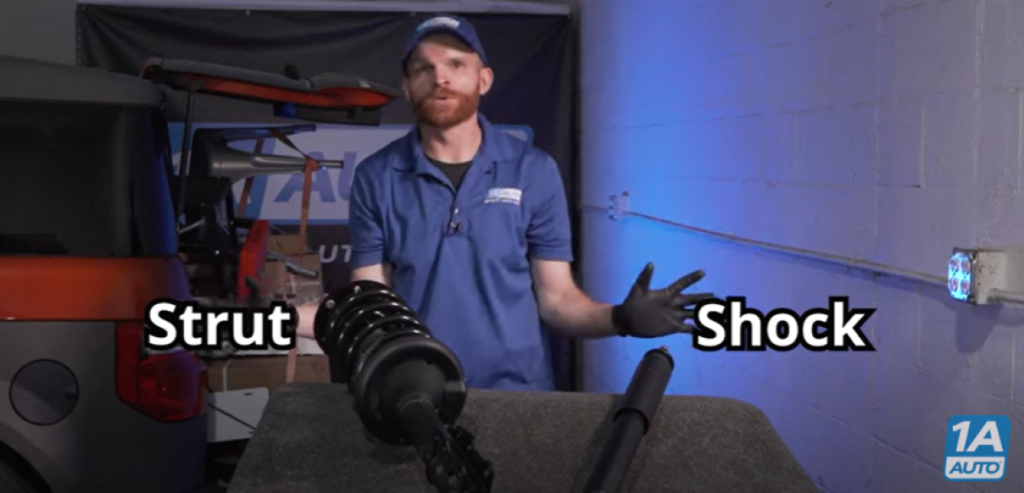If your car is bouncing while driving, has poorer gas mileage, or you notice it doesn’t sit as level as it used to, it’s time to inspect your shocks and struts. Learn the difference between the two, the signs of these parts will show when they’re failing, and how to fix it yourself with these expert tips.
Why Is My Car Bouncing or Not Sitting Level?

If your car is not sitting at it’s normal level, it could be overloaded. If it’s bouncing up and down while driving, it could have bad shocks and struts, and both affect fuel economy. This guide will review what shocks and struts are, where they’re located, how to diagnose them, and how they can affect your fuel economy.
What Are Struts and Where Are They Located?
Generally, struts are located at the front of the vehicle. All of the weight of the engine and transmission is on them. The struts have a coil spring around them for more strength when absorbing bumps from driving down the road.
More on the difference between shocks and struts
How to Tell If a Strut Is Bad

Look for Sagging at the Rear or Sides, or Bouncing from Your Car When Driving
Check if the vehicle is sagging from front-to-rear or side-to-side. Another way to tell if the struts are bad is if your car feels bouncy or bumpy when driving. It’s normal to feel a few bumps, but the struts could be worn if your car is excessively bouncy and dips up and down too much.
Inspect the Strut for Cracking or Leaking
Lift the vehicle off the ground with a jack and jack stands for a better view of the struts. Check the spring and make sure it’s not broken or weak. See if the strut is leaking. You do not want to see oil leaking down the side. If oil is leaking, the seal is bad and entire strut needs to be replaced.
More on how to tell if your struts are faulty
What Are Shocks and Where Are They Located?

Like struts, shocks also help your vehicle absorb impacts from the road. Generally, shocks are located at the rear. Unlike struts, they don’t always have a spring. You may see small coil spring around the shock, but it’s common to not have one.
You may also notice a separate coil spring at the rear of the vehicle, and you’ll find one at the rear on a lot of cars and maybe some trucks. Trucks sometimes don’t only have shocks at the rear, but also sometimes they’ll have a large coil spring at the rear and a leaf spring laid across. This spring is for heavy duty scenarios so you don’t have to worry about the vehicle being overloaded.
How to Tell If the Shocks Are Bad
Inspect the Shocks for Leaking
Look closely at where the piston comes down into the casing. If you see fluid leaking, it means a seal is broken. The shock has gas that’s supposed to remain inside, so you’ll want to replace the shocks if it’s leaking.
Look for Sagging at the Rear or the Sides, or Bouncing from Your Car When Driving
You may notice the rear of your car or truck bouncing up and down as you drive. It may also sag down too much when weight is in the back. If you notice the rear of your vehicle bumping up and down excessively while driving, it might be time to replace the shocks.
Regardless of the symptoms, bad shocks and struts can affect fuel economy.
How Do Bad Shocks and Struts Affect Fuel Economy?
If there’s a problem with your suspension parts, you could have a drag-resistance problem. When the front of the vehicle is sagging down, there will be wind resistance along top of vehicle. If the rear of the vehicle is sagging down, more wind will flow underneath the vehicle. This airflow will cause resistance, and any drag or resistance from suspension problems at the front or rear will cause your vehicle to waste more gas to run.
If your vehicle is sagging to one side or the other, that typically means there’s a problem with one strut, shock, or a coil spring if you have one. This will the change alignment angles of the vehicle. Instead of having wheels driving straight down the road, which is optimal for fuel efficiency, a sagging wheel may angle one way or another. That will cause more restriction or resistance on the ground, eat up tires, and cost you more for the repair.
Learn to Replace Shocks and Struts Yourself
Purchase a Strut Assembly
If replacing the shocks or struts, we recommend replacing both at same time. This will keep your vehicle level and prevent you from having to replace the other later, which is likely on its way to wearing out if these parts have been in use.
You can choose to repair a component on a strut and piece it together with a machine. You can also purchase a complete assembly with the strut, spring, and cap.
If you choose to buy the strut without any components, the spring can still wear down over time and you may find your car bouncing again sooner than you’d expect. The strut cap along the top has bearings, and those can also fail. It’s also dangerous to dissemble a strut compared to replacing one with a complete assembly.
Use Our How-to Videos
Our how-to videos can help you replace the shocks and struts yourself. We have videos related to specific models with step-by-step instructions by experienced mechanics.
Get a 4 Wheel Alignment
After you’ve replaced the shocks or struts, we recommend you bring your vehicle to a professional shop for a 4 wheel alignment.


